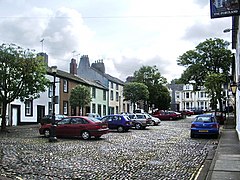Workington
| Workington | ||
|---|---|---|
| Portland Square | ||
| Coordinates | 54 ° 39 ′ N , 3 ° 33 ′ W | |
| OS National Grid | NX996279 | |
|
|
||
| Residents | 21,514 (as of April 29, 2001) | |
| administration | ||
| Post town | WORKINGTON | |
| ZIP code section | CA14 | |
| Primaries | 01900 01946 |
|
| Part of the country | England | |
| region | North West England | |
| Shire county | Cumbria | |
| District | Allerdale | |
| Civil Parish | Workington | |
| British Parliament | Workington | |
Workington is a town of 24,295 inhabitants (2001) and a Civil Parish on the west coast of Cumbria , England at the mouth of the River Derwent .
Workington has long been known as a producer of coal , steel and high quality iron ore .
history
A Roman camp now commonly known as the Burrows Walls was built in the 2nd century as part of the Cumbrian coastal defenses and continuation of Hadrian's Wall . The camp on the north bank of the Derwent also had a watchtower on the south bank, which was also part of the fortification system.
In 1568 Mary Queen of Scots spent her first night on English soil in Workington, fleeing the Battle of Langside .
The iron ore deposits at Workington were mined for a long time. The deposits were of great importance when Henry Bessemer developed the first process for the mass production of steel. In its early days, the process required particularly low-sulfur ore, and this can be found in the vicinity of Workington together with the coal required for processing. Until 1977, steel was produced in Workington using the Bessemer process, and the steelworks closed completely in 2006.
With the end of steel production, Workington lost its largest employer and unemployment became a major problem for the town in the structurally weak region. The British Cattle Movement Service , which monitors the UK's cattle population after the BSE crisis , has been established in Workington.
Of the original three stations that existed in Workington, today only Workington (Main) station of the Cockermouth and Workington Railway is operated as Workington station on today's Cumbrian Coast Line . The station Working desk Bridge of Cockermouth and Workington Railway and the railway station Workington Central of Cleator and Workington Junction Railway were closed.
Workington was severely affected by the flooding in Cumbria in the aftermath of extreme rainfall in November 2009. Two of three road bridges over the Derwent in the inner city area were destroyed on November 20, 2009 and the third was badly damaged. Network Rail therefore operated the Workington North temporary station between November 30, 2009 and October 8, 2010 , as the railway bridge was undamaged and all trains on the Cumbrian Coast Line stopped at both Workington and the temporary station and thus a connection between the districts north and south of the Derwent for pedestrians.
The new construction of the Northside Bridge, which was destroyed in the flood of 2009 and began construction in 2011 and officially opened in October 2012, won the Builder and Engineers Award in 2013 after having previously won other architecture prizes.
Town twinning
-
 Selm ( Germany )
Selm ( Germany ) -
 Val-de-Reuil ( France )
Val-de-Reuil ( France )
Sports
The Speedway team of the Workington Comets starts in the British Speedway Premier League.
swell
- Richard Byers: The History of Workington. An Illustrated History from Earliest Times to AD 1865. Richard Byers pub., Cockermouth 1998.
Web links
- Workington on Visit Cumbria
- Network Rail to build new temporary station to help Workington flood victims ( Memento from November 25, 2009 on WebCite ) Network Rail, November 24, 2009
- Workington-North to close on 8th October by Rail-News.com, September 14, 2010
Individual evidence
- ↑ Workington's new Northside Bridge wins engineering award on BBC News , November 17, 2013, accessed November 18, 2013.

